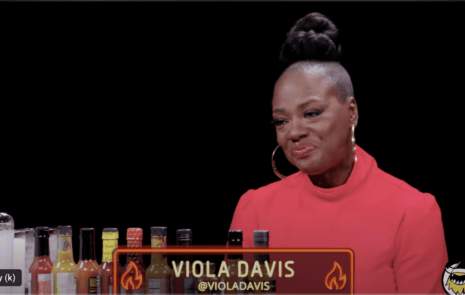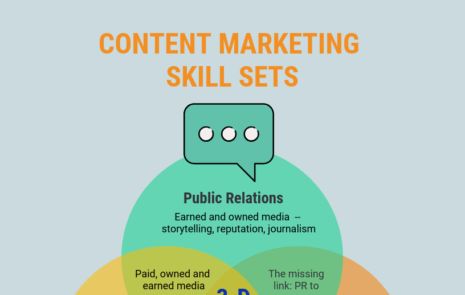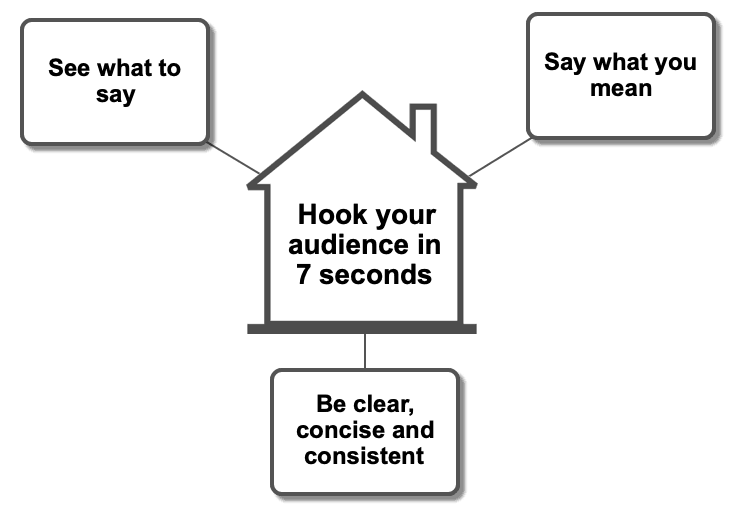
How Can You Keep Your Content Marketing Always on Message?
How to keep your content marketing always on message?
It’s a tough job: to keep all your company’s marketing and communications on message as you address customer segmentation.
As a marketer from Ingersoll-Rand asked, “How to speak to diverse audiences while maintaining a holistic experience across properties?” This messaging challenge ranks among the Top 100 Questions on content marketing.
How can you develop a unified message that addresses each audience segment, each customer type, effectively? That is, how do you unify marketing around one consistent message — even when your brand comes with built-in market segmentation, customer segmentation, audience segmentation, and more?
How can you keep your content marketing always on message and consistent in the face of multiple challenges?
Audience segmentation is just the tip of the iceberg.
It’s a tough job to keep content marketing always on message when you:
- Address multiple stakeholder segments such as customers, partners, distributors, employees, influencers, and investors.
- Work with various bloggers, agencies, spokespersons, writers, and videographers to create content.
- Create content inside separate business units, sales, geographic regions, and department silos that may not even agree on what the one consistent message is.
- Create content across many media – digital, social, live, and virtual events, videos, podcasts, printed materials, earned media, and more.
- Chunk out consistent content in multiple serving sizes such as 7 seconds, 2 minutes, or 20 minutes.

Do these challenges sound familiar? CEOs, executives, marketing, public relations, and investor relations people face these challenges every single day.
Out of all the messaging frameworks you can choose to help you get the right message to the right customer, here’s one that’s simple, intuitive, and visual. It enables you to connect with people quickly by delivering a message that’s meaningful to each segment of your audience.
For decades, my teams have kept companies on message with an easy-to-learn tool called a Message Map. See “What Is A Message Map?”
My late friend Tripp Frohlichstein and I co-invented Message Maps in the 1980s. Since then, we’ve taught Message Maps to thousands of marketers and communicators.
Companies of all sizes use Message Maps, from entrepreneurs to giants like AT&T, The Home Depot, and Intel.
We teach marketers how to co-create Message Maps in workshops for clients and members of the Association of National Advertisers.
The magic of a Message Map
A Message Map enables you to:
- See what to say
- Say what you mean
- Keep it clear, concise, and consistent.
A Message Map fits your whole message on one page. It helps you to deliver the perfect size packet for the human brain — a sound bite of just 7 seconds, 23 words or less. That’s exactly what customers, employees, news media, and other audience segments need — one consistent message that hooks them before they turn suddenly impatient.
The elements of a Message Map include:
- One main message is called home base.
- Three reasons to believe your main message, are called positive points.
- Reasons to believe your positive points are called proof points.
Professionals who use a conventional message framework find that it takes weeks or months to build internal buy-in for a message. Reviews seem endless as you struggle to build a consensus.
In his speech at a Marketing Profs B2B Conference, Doug Kessler poked fun at the traditional message stack process in the slide below. The catch is, that this process takes too long to be effective – several months!
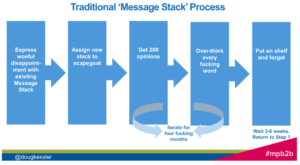
In contrast, a Message Map enables you to create a message and gain buy-in in one day or less.
Start this morning, and you can have an agreed-on message in your hands tonight — ready to go to customers tomorrow.
How can you build buy-in to the message so quickly? The secret is to co-create your Message Map in a facilitated 4- to 8-hour session with all the key decision-makers around the table (or on Zoom).
At a company level, that means rounding up your CEO, the C-suite, and subject-matter experts who need to have a say in the message.
The ideal size group to co-create a Message Map is about 10 people, plus or minus.
That said, our facilitators have worked with groups as large as 50 people when, for example, a consortium of dozens of nonprofit organizations and government agencies needed to find common ground on which to build one consistent message for their cause. Talk about segmentation!
With help from an experienced facilitator, you can create an agreed-on Message Map in a day or less.
First, focus on one main message, your home base
Neuroscience shows that, in the human brain, consistency equals credibility. To gain credibility, deliver one message to your audience consistently over time.
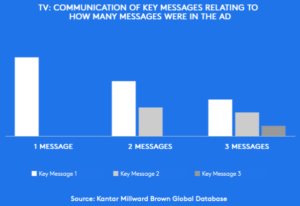
This may be the hardest part of messaging, especially when you communicate with different stakeholders. You may be juggling market segmentation, audience segmentation, and psychographic segmentation all at the same time.
Coming up with one consistent message you will deliver again and again is the key to success. Why?
Because as Seth Godin advises: “If you try to say three things, we will hear nothing. Because most of the time, we’re hardly listening.”
A Kantar Millward Brown study shows why you need to stick with one message. The more messages you try to cram into any given communication, the lower the likelihood that a single message will stick with your audience.
That’s why a Message Map requires you to focus on one main message, called home base. The crucial job of the home base is to engage all your audiences and stakeholders emotionally by answering their question, What’s in it for me? (WIIFM?)

As you deliver your message in live, digital and print media, repeat your home base message consistently, to enable it to sink in with your audience.
The home base is a crucial starting point. But by itself, isn’t sufficient to break through to people. People need good reasons to believe in your home base.
Give people 3 reasons to believe
Once you have a home base, give people 3 reasons to believe it, known as positive points. Positive points make your home base believable.

Why 3 positive points? Because 3 is a magic number for humans. We love pattern recognition, and it takes 3 things to create a pattern. That’s why we have Three Wise Men, Three Blind Mice, and traffic lights that are red, yellow, and green.
Below you’ll see a Message Map template that shows the anatomy of a 7-second Message Map, with one home base and 3 positive points.
When it’s absolutely necessary, you can use 4 positive points to support your home base. But 4 is the max.
Why? Because neuroscientists say that’s the absolute limit for the human brain to absorb.
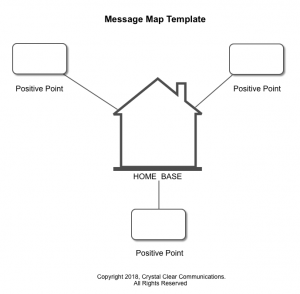
Now you have the essence of your message: a 7-second message that hooks your audience quickly and leaves them hungry for more. The right message successfully addresses the needs of your market segmentation, customer segmentation, and stakeholder segmentation.
A 7-second message generates ideas for headlines, email subject lines, social media posts, a sound bite for news media, or an elevator speech.
Imagine all the communications you can create quicker, once you have an agreed-on, absolutely consistent 7-second message for your company or brand.
Message Maps keep you on one consistent message
A Message Map helps you say it, share it, tweet it, blog it, post it, text it, publish it, or debate it well. By using Message Maps consistently, you can make your marketing, employee, and investor communications harmonious and even more successful.
Message Maps help you to display a command of the facts, stay crystal clear, and tell the same company story consistently.
When delivered well, Message Maps make your main message sticky. That’s crucial because:
- When your company is quoted in news media, the average sound bite is about 7 seconds or 23 words.
- To maximize sharing, the optimum length of a post on Facebook is 15 words. On LinkedIn, it’s only 9 words, a BuzzSumo study found.
- The best length of a text message is less than 100 characters.
- If you can’t tell your story in 7 seconds, you probably won’t get to tell it at all.
A clear, concise, consistent message wins people over
Start by creating an overall, top-level Message Map for your whole company in a workshop. Work with a facilitator to co-create a company message with your CEO and executives.
In the workshop, your facilitator will share the anatomy of a 2-minute Message Map:

- Home base, in the center of the map, is your main message. It must answer the question, “What’s in it for me?” as seen through the eyes of all stakeholders.
- To support the home base, add 3 positive points. You need at least 3 points to support the home base message well — and no more than 4 points.
- To support the positive points, add 3 proof points to back them up.
- To support your proof points, add examples, quotes from customers, images, facts, and figures.
- Include differentiating points: What makes your story different? What can you say that competitors can’t say? These often are the hardest elements to ferret out — but they make your message far more powerful.
Examples of Message Maps
Here’s a 19-word message about a hotel I often stay in: The Virgin Chicago Hotel.
The Virgin Chicago Hotel delivers a great guest experience (home base) with a convenient location (positive point), comfortable rooms, ready for business (positive point), and “It’s Virgin! It’s fun!” (positive point).
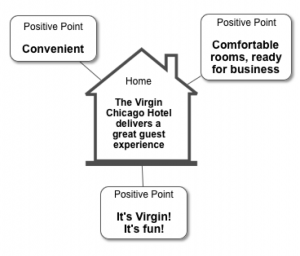
Once executives understand the principles behind a Message Map, the facilitator asks each exec to individually create a Message Map about the company. This exercise reveals what are the stories execs tell about your company or brand right now.
You might be surprised by how many different stories they’re telling. That’s what happens when the leaders haven’t agreed on one consistent story to tell.
Starting out, they use the 7-second Message Map template above to outline their story.
For more ideas to keep content marketing always on message, subscribe to our blog.
The facilitator then posts everyone’s Message Maps on the wall. Each message creator reads his or her message out loud to the team.
That’s the moment of truth. It’s when executives find out that:
- They are all telling somewhat different stories about the company.
- Some of these stories don’t even sound like they could come from the same company.
- The company has an unmet need for a unified story. It needs a way to keep its story consistent and relevant through all its audience segments.
Such realizations lead executives into an intense discussion. Their focus: which parts of the story work best? Which don’t?
On a whiteboard, the facilitator extracts the best parts from each exec’s story to map out a unified story that's co-created by the team in real time.
That’s when the haggling begins. With only 23 words to work with, the execs will debate each and every word. Passionately, sometimes even furiously.
This process of co-creation is how they find exactly the best words to tell your company's story.
To differentiate, expand your Message Map to 2 minutes
When you expand the Message Map for the Virgin Hotel Chicago to 2 minutes, you see lots of differentiation, which is color-coded in yellow on the Message Map below. All the yellow points demonstrate how Sir Richard Branson disrupts a market like hotels with new ideas.

Make your message the optimal size for human brains to receive
Invest all your energy and budget into discovering and supporting the single overarching message about your company -- one that all your stakeholders, market segments, and audience segments need to know.
Since multiple messages only confuse people, forget about making unique messages to each of your audience segments, demographic segments, psychographic segments, and so forth. What you need instead is a unifying message that addresses all of these audiences.
Once your executives agree on a home base and 3 positive points, you've created an optimal-sized message for humans.
Dr. Carmen Simon, a cognitive neuroscientist, found that people can only absorb one main message at a time, supported by 3 (or no more than 4) positive points.
Once the home base and 3 positive points are agreed on, you’ll expand your Message Map by adding proof points.
By the end of a workshop, executives have co-created your Message Map
After the workshop, have them review the Message Map, check the facts, and polish it up.
Then, you will need to do the legwork to add stories, anecdotes, and more examples to create a full-scale Message Map.
Give yourself a journalist's license to pursue the company's story. Ferret out the company's best anecdotes and add them to your Message Map.
A full-scale, 20-minute Message Map includes as many as 40 message elements:
- 1 home base
- 3 positive points
- 9 proof points
- 27 examples
- Include differentiating points (coded in yellow): things your competitors can't say.
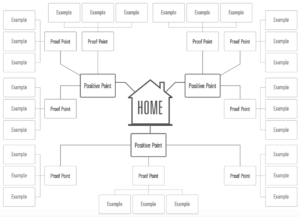
Now, you have a robust, 20-minute message that is ready to serve as the foundation for all the communications and content your company creates. It gives you the bedrock on which to build a website, an event, a report, a speech, a presentation, a brochure, or a news media interview. That's the power of a Message Map!
Here's the anatomy of a fully built-out Message Map with a home base, positive points, proof points, and examples.
Before you roll it out, take the time to test your Message Map by using these 10 tests to assure its relevance and resonance with your audiences.
For more ideas to keep content marketing always on message, subscribe to our blog.
Preview | Powered by FeedBlitz
Keep your message clear, concise and consistent
With your company's Message Map in hand, you can build all your marketing, communications, employee, and investor messages with utter consistency. Use your Message Map to train sales, marketing, service, and other employees on how to deliver your message.

When everyone delivers the same message, it's like everyone in the choir singing from the same song sheet. Such harmony!
A Message Map gets everyone on the same page, so your brand or company message is backed up by the whole choir. And you address the needs identified in your market segmentation, audience segmentation, and demographic segmentation.
Keep your Message Map Fresh
As time goes forward, add new products, customer wins, market expansions, events, and examples to your Message Map.
Update it at least quarterly to keep the message fresh and current. Or, add a news hook from today to keep it newsy.
Build a set of Message Maps for your company to keep content marketing always on message.
Use this same process to create a Message Map for each product or solution your company sells.
To create Message Maps for business units, product lines, products, services, and geographical regions, convene the relevant product managers, R&D, sales, marketing, and other participants to co-create a Message Map.
With a facilitator to drive the process, you'll gain buy-in more quickly than by any other method. When you co-create the message, everyone shares a stake in its success.
Tripp used Message Maps to prepare executives for news media interviews, presentations, speeches, and by-lined articles. I apply Message Maps for all of those jobs plus marketing, websites, videos, infographics, annual reports, earnings releases, news releases, collateral, magazines, trade shows, employee communications, and more.
Tripp and I co-created Message Maps for companies such as AT&T, McDonald's, RR Donnelley, TeleDanmark, Intel, Ameritech, and Tellabs. We showed that the Message Map process can scale to fit any size organization – from a one-person shop to a small nonprofit to a medium-sized business to a Fortune 500 or Fortune 50 company.
To address the different people in your audience, color-code your Message Map for each buyer's persona
Particularly when multiple buyer personas are involved in a purchase, you will need to color-code the relevant message elements. You can also use color coding to address market segmentation, audience segmentation, customer segmentation, geographical segmentation, and so forth.
Start with a black-and-white Message Map, then color-code message elements for each audience. For example, you can use the same Message Map and highlight it in blue for technical buyers, red for financial buyers, and green for environmentally-focused buyers.
Color coding assures that you only deliver the relevant parts of the message to each audience.
Only share the parts of your message that are relevant to each buyer persona. Don't bore anyone with information they don't care about.
For example, here’s a 7-second Message Map about The Home Depot’s paint department.
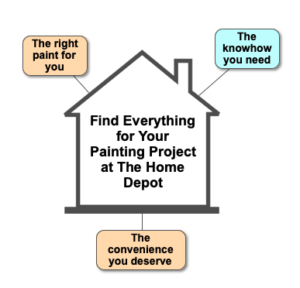
The orange elements of the message apply to all Home Depot audiences, including do-it-yourselfers, contractors, and people who hire contractors. Blue applies to contractors only.
Now let’s expand the Home Depot paint message to 2 minutes. In this Message Map, the salmon color applies to people who hire contractors. Orange applies to everyone, while blue continues to apply to contractors only (segmentation by customer type).
As you see, the 2-minute Home Depot message is completely consistent with the 7-second message. What’s more, this message gracefully scales up to 20 minutes.

Have a question about Message Maps? Would you’d like to see the 20-minute version of the Home Depot Message Map? Either way, email me at george@crystalclearcomms.com
For more ideas to keep content marketing always on message, subscribe to our blog.
Keep your company message clear, concise, and completely consistent.
With your company's Message Map in hand, you can build all your marketing, communications, and investor messages with complete consistency. Use the Message Map to train sales, marketing, service, and other employees on how to deliver your message to customers consistently.
When everyone uses the same message, it's like everyone in the choir is singing from the same song sheet. Such harmony!
Keep your Message Map fresh to keep content marketing always on message
As time goes forward, add new products, customer wins, market expansions, events, and examples to your Message Map. Update it at least quarterly to keep the message fresh and current.
And feel free to newsjack today's stories to add interest to your evergreen content. You can learn more about this from David Meerman Scott's book, Newsjacking.
This blog answers a question raised at Content Marketing World after my presentation, How to Speed the Journey from Content to Cash.
What is a message map?
Top Content Marketing Questions Answered
For more ideas to keep your content marketing always on message, subscribe to our blog.
How to keep content marketing always on message.
Related Posts
Marketers, always be teaching buyers and customers
To win at content marketing, always be teaching (ABT) In Glengarry Glen Ross, a sales manager Blake (Alec Baldwin) teaches the lesson: ABC, always...
Viola Davis on how to reach your audience
I didn’t set out to write a blog on how actress and producer Viola Davis can help you reach your audience. I set out...
Top 100 Content Marketing Question: ‘How can I help with content marketing?’
I love this question: “How can I help?” Whenever I hear a question like this, I pay lots of attention to who’s asking. Because...
Virtual presentations: What you need to know to succeed.
Virtual presentations: Will they be the new “normal”? The conference you submitted to speak at accepted your proposal. You were geared up to travel...


